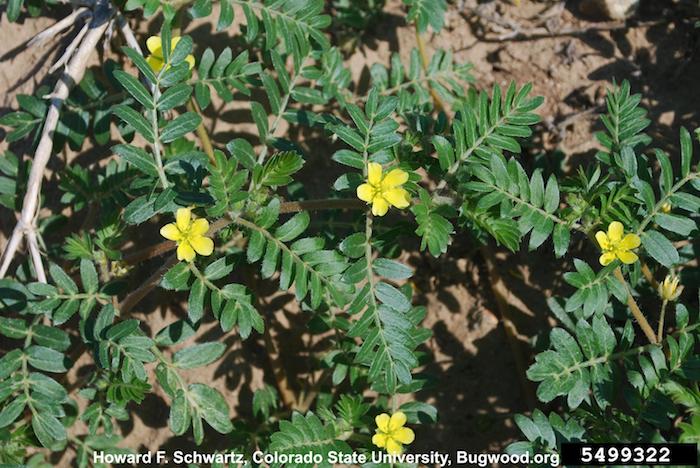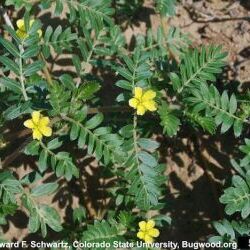
Priority: Eradicate
General: Low-growing vine-like plant with hard, spiked seeds that can puncture tires.
Height: Usually grows along the ground but can grow upward if trying to access light.
Flowers: Yellow flowers with 5 petals. Flowers open in the morning only.
Leaves/Stems: Leaves are oval and 5-15 mm long arranged oppositely along the stem. Stems branch and spread up to 100 cm wide.
Root: Shallow taproot.
Goat’s-head, Bullhead, Caltrop, Tackweed
Not many look alikes but could be confused with other plants that are ground creepers forming mats. Prostrate knotweed (Polygonum aviculare), Prostate spurge (Euphorbia maculata), Common Silverweed (Potentilla anserina).
Where did it come from? Introduced from Eurasia.
Where does it grow here? Thrives in dry grassland, fields and disturbed areas. It has been spreading in the vineyards of the Okanagan. It can tolerate a wide range of soil conditions.
Reproduction: Grows by seed only. The fruit is spiny with 5 sections that split open when it matures. Each bur has 2 spines each with 2-5 seeds. The seed can stay viable in the soil for up to 5 years. One plant can produce up to 1 million seeds.
When does it grow, flower & seed? Sprouts May and throughout season until October. Flowers 3 weeks after first growth. Seeds 1-2 weeks after flowers.
Spreads By: The spines are very sharp which cause them to stick to shoes, tires, animals and wine grape containers.
Plant Type: Annual.
- The spiny burs can damage equipment on farms and harm livestock. They can injure people.
- If ingested, puncturevine can be toxic to sheep.
- Review your property regularly for this species. Especially check equipment, tires, and gear for burs.
- Treatment Remove small patches before it flowers & sets seed. Hand removal or hoeing can be effective for very small patches especially of young plants. Mulch layer of at least 7-8cm thick can be effective to suppress young plants.
- Cover bare patches or disturbed soil by planting or seeding with non-invasives.
- Check areas where you have removed invasives for any new plants that year and in future growing seasons. Seed can stay viable in the soil for up to 5 years.
- Dispose of invasive plants responsibly. Bag them for disposal at the local landfill. Composting and burning is not recommended.
- Contact LRISS for specific treatment recommendations.
Okanagan Invasive Species Online website
E-Flora BC: Electronic Atlas of the Flora of British Columbia
